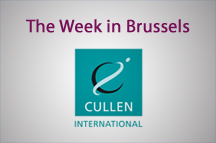 Commissioner for the Digital Economy and Society, Günther Oettinger, set this challenge in a speech on 17 November, “If we want to reach the vision of a Digital Union based on a functioning single market there is one thing we need: unconstrained connectivity … Our rulebook must set the right frame to ensure unconstrained connectivity.”
Commissioner for the Digital Economy and Society, Günther Oettinger, set this challenge in a speech on 17 November, “If we want to reach the vision of a Digital Union based on a functioning single market there is one thing we need: unconstrained connectivity … Our rulebook must set the right frame to ensure unconstrained connectivity.”
Not easy …
It is a difficult challenge. The regulatory framework must strike the appropriate balance between maintaining or even enhancing competition, while encouraging the large investments needed to provide widespread high speed broadband access. Then, there is the problem of finding sufficient public funds or other incentives to ensure that broadband will reach into those (largely rural) areas that private investors will not find commercially attractive.
Competition and investment
Incumbent operators and challengers disagree vehemently on the appropriate regulatory approach to achieve the investment/competition balance. ETNO, the incumbents’ association, wants wholesale regulation to be relaxed, even to be the exception, with commercial terms for access. ECTA, for the challengers, says this will lead to re-monopolisation. ECTA members and consumer organisations have set up lobby groups, the ECTA CEO Council and #NetCompetition, to argue that it is only competition that will drive efficient investments and, in any case, investment is only the means to the end goal of high quality services for customers.
Mr Oettinger says it is not competition vs investment but that both need to succeed. He advocates “a more granular approach”, rewarding risk by allowing investors to use their comparative advantage. This could indicate a possible loosening of access regulation for new fibre networks, retaining regulations only for existing (copper) networks.
Universal connectivity
 Broadband rollout in certain geographic areas will be less attractive to private investors and public funds will not be available to plug all the gaps. Mr Oettinger asks whether these “challenge areas” require regulatory incentives, such as lighter access regulation and allowing providers to insist on longer contract terms.
Broadband rollout in certain geographic areas will be less attractive to private investors and public funds will not be available to plug all the gaps. Mr Oettinger asks whether these “challenge areas” require regulatory incentives, such as lighter access regulation and allowing providers to insist on longer contract terms.
Radio spectrum
The extent of the challenge areas can potentially be reduced significantly by the use of wireless broadband technologies. Mr Oettinger explicitly recognises this point, calling the future mobile 5G technology “a game changer”. Of course, the Commission has long wished to have more of a say in radio spectrum policy, and Mr Oettinger does not waste the opportunity to demand European “spectrum coordination mechanisms”.
On this point, market players seem to be in agreement, with most participants at the Commission’s recent public hearing favouring greater harmonisation over spectrum. However, the Commission here faces the problem of persuading EU member states to give up their areas of competence on many spectrum issues. Mr Oettinger has signalled that he wants to find some common ground with the member states to avoid deadlock when the legislative proposals are submitted.
Many questions, no obvious answers
The current review raises these and many other complex questions, as evidenced by the 111 page questionnaire through which the Commission is consulting stakeholders until 7 December. The legislative proposals that will emerge, expected by mid-2016, seem certain to continue to generate heated debate.














